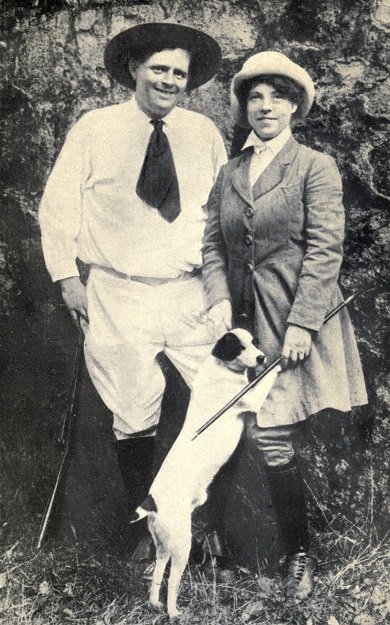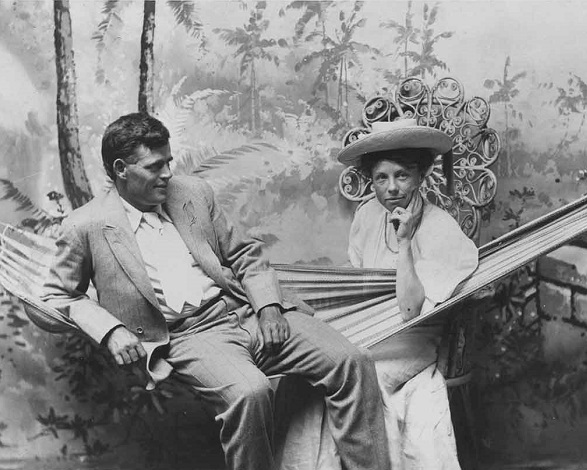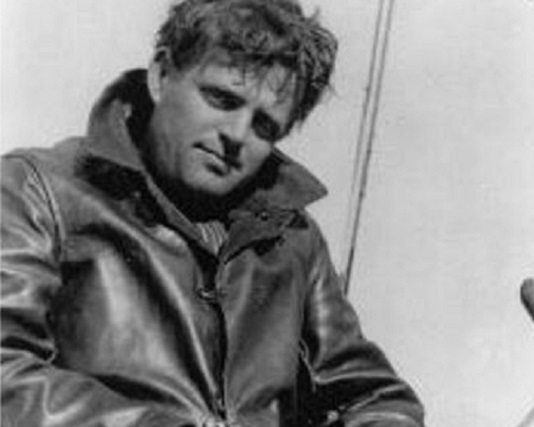Jack London - The man who lived not because of the world's opinion about him, but because of what he thinks of himself.
Jack London was born on January 12, 1876, in San Francisco, with birth name John Griffith Cheney (his documents were lost during the great earthquake in San Francisco in 1906). His biological father is considered to be the time-honored "professor" astrologer William Cheney, but the writer carries the surname of his adopter. As a young man, Jack learns that he is not the son of the man he considered his father and writes to William Cheney, but he receives a cold answer from him in which he points out that he has never been married to his mother, that it is impotent. Jack's childhood is in poverty. After completing his primary education in 1889, he began working in a canning factory on a 12-hour working day, with working hours often extended up to 16 hours.
Seeking a way out of this unbearably hard work, Jack London borrows money, buys an old small boat and becomes an oyster hunter without a permit. In a few months, however, the ship is very cramped and does not make any difference. Then London crossed to the law and became a member of the California Fisheries Patrol. In 1893, he traveled to Japan on board a schooner for sealing. When he returns, he finds Oakland (California) in riots of workers' protests. Jack London is already out of work and becomes a bum. In 1894 he spent 30 days in prison for wandering. After a series of adventures, London returned to civilized life, graduated from secondary school, and managed, with hard work of self-training throughout the summer, to enter the University of California in the autumn of 1896. Yet the following year, however, he was forgiven with his dream of higher education due to parlance. Throughout his life, Jack London has been self-educated. He is a man with all-round interests. His personal library numbers 15,000 volumes.
In 1897, London left for Klondike's golden fever, and became a gold digger by acquiring material for his first successful stories. Now you can see his Alaska house, halfway up from the original house he used to live near the port of Oakland in a square named Jack London Square, the other half of the original house in Canada. Jack London comes to the conclusion that his only hope is to receive education and "sell his brain". Throughout his life he sees writing as a job, it is his ticket to escape from poverty, a means to defeat the rich by playing their rules. At that time, London became a socialist. He began writing stories and from 1898 made serious attempts to publish - this battle was described unforgettably in his novel "Martin Eden" (1909). For his first published narrative, he gets only $ 5, and for a while he does not give up on a writer's career. In his own words, he was "saved in the literal and transient sense of the word," when another account of his story was accepted and paid well for as much as 40 dollars. In 1900, he already owns $ 2,500, equivalent to about 50,000 today.

6 days before London's death 1916
In 1901, the Socialist Party raised Jack London's bid as mayor of Auckland, but the election won another candidate. London then lends itself to a stubborn writer's work, which keeps him popular throughout his life. He writes both artistic and publicistic works. His first novel, The Son of the Wolf, was published in 1900. In the Divine Call (1903), the huge home dog, Buck, discovered that his instinct forced him into the wild and became the leader of a wolf pack. "The White Tooth" (1906) and "Burning Daylight" (1910) are greeted with the lively interest of the wide audience. In 1902, Jack London went to England, where he studied the housing conditions in the East End, London's slum. The result of his observations is the book "People of the abyss" (1903), which has unexpectedly great success in the United States but has been severely criticized in England. In 1906 London published the essay "The War of the Classes", among which were his lectures on socialism. In 1900, Jack London married Elizabeth (Bess) Madern, but their home became a battleground of clashes between her and the mother of London. Three years later, he left his first wife and two daughters, and later married Chariman Kitrige, an editor and admirer of outdoor sports. "Journey with Snark" (1913) is a memoir of Jack and Charles London's journey through the Pacific (1907-1909). Their marriage continues until the writer's death. Charmian is a prototype of many female characters in London's work, such as Paola from The Little Hostess of the Big Home (1916).
In 1910, Jack London bought a thousand-acre (4,000-acre) ranch in Glen Ellen, Sonoma County, California for $ 26,000. He writes, "After my wife, the ranch is the most expensive thing in the world for me." Writing, always a commercial activity for him, is now becoming even more a means of making money. "I write books only to add more acres to my magnificent mansion." In the last years of his life he is feeling split. His socialist views are in conflict with his love for his own property. In 1916, he left the Socialist Party, saying it only because of its party "lacking fire and struggle, and losing its interest in class struggle." Many readers believe that Jack London is the best in a short story. Indeed, his stories are a short prose for his impeccable construction, and his novels often remind of a related series of stories.

Jack London and his second wife Charmian
"Shooting Fire" from his Klondike period is perhaps his most famous story. Other stories from the same period are: "The Golden Canyon" for the battle between two gold miners; "The Law of Life" for an old man, abandoned by his tribe to die alone; "Thirst for Life" - for the treacherous journey and survival of a gold digger through the Canadian taiga.
Much of London's work today is classified as fantasy and fantasy: The Incomparable Invasion describes a bacteriological war against China; Goliath is an invincible energy weapon; "Pliocene Relics" is fantasy for the meeting of a modern man with an ancient mammoth; "Shadow and Glitter" is an intriguing story about two brothers in constant rivalries who invent two distinct ways of gaining invisibility; "Red" is for the islanders, fascinated by an alien object. In his black utopia for the 27th century, The Iron Heel (1908) talks about terrorist attacks: "The list of martyrs has grown enormously. Numerous executions were carried out everywhere. Out-of-law people and fugitives slipped through the mountains and deserted areas and were ruthlessly pursued [by the Iron Fist]. In our shelters came comrades for whose heads awards were announced.
Many of the comrades were discouraged and avenged by terrorist actions. Failures killed their dreams and brought them to despair. Many terrorist organizations, unrelated to us, rose like mushrooms after rain and caused us great problems. These uninfluenced people were indiscriminately sacrificing their own lives, their plans often did not go as they cut them and so delayed our organization. " "The Way" is a series of stories and memories of London's wandering days and preceded with half a century the cult book of Jack Kerouac, On the Way. John Barlikorn's autobiographical book about "alcoholic memories" was published in 1913. Today, "Alcoholics Anonymous" recommend it because it describes extremely well the external and internal life of an alcoholic. Passages that stop the mental state that London calls "White Logic" are among the most powerful and shattering descriptions of alcoholic experiences. However, does the question arise, in fact, whether it is a book against alcohol or an anthem of alcoholic intoxication? London gives alcohol a variety of nuances - he is exciting, dangerous, comrade, glorious, masculine. Alcohol is an adventure like other adventures - an integral part of all adventures. Still, he finally comes to the conclusion: "No, I made a decision - I will only drink from time to time."
.jpg)
Mary Austin, Jack London, George Sterling and Jimmie Hooper
Death to Jack London is controversial. His death certificate states that he died on 22 November 1916 from uremia (a common intoxication in acute renal failure). But according to rumors, among his contemporaries, he committed suicide. According to one of the versions, he has died of an overdose of morphine, which he has taken in recent years for severe pain. The dust of his mortal remains, along with his wife, Charmian, is buried in a simple tomb in Glen Ellen, California, marked with only a large round stone overgrown with moss.
